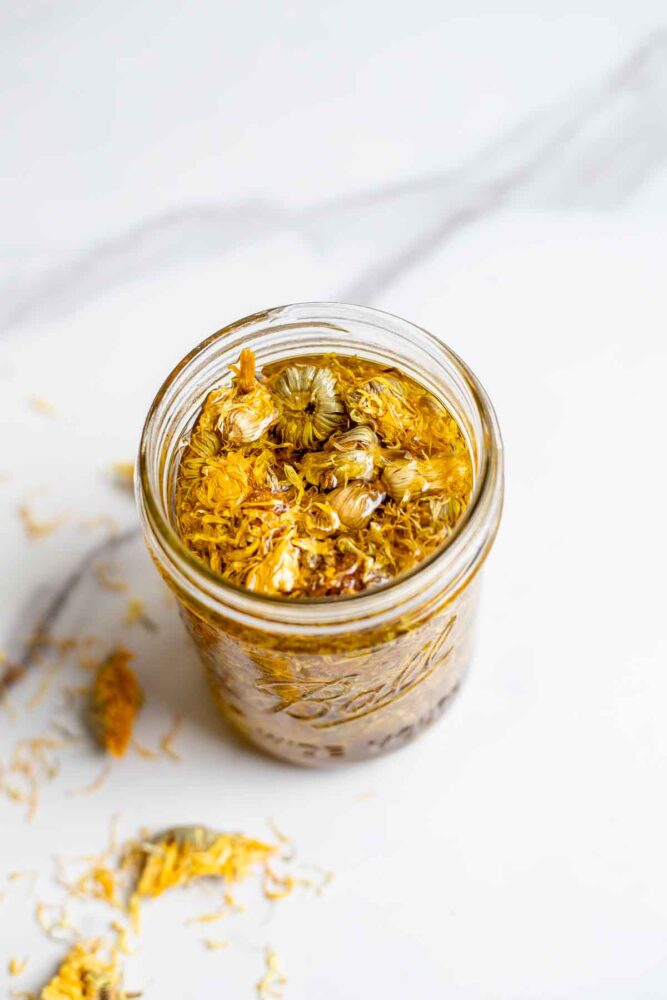How To Make Calendula Oil
This post may contain affiliate links. Read disclosure policy.
Learn how to make calendula oil with just a few ingredients and a little bit of time. This calendula-infused oil is a versatile product that you can use on your entire body, and is a great addition to your natural medicine cabinet.
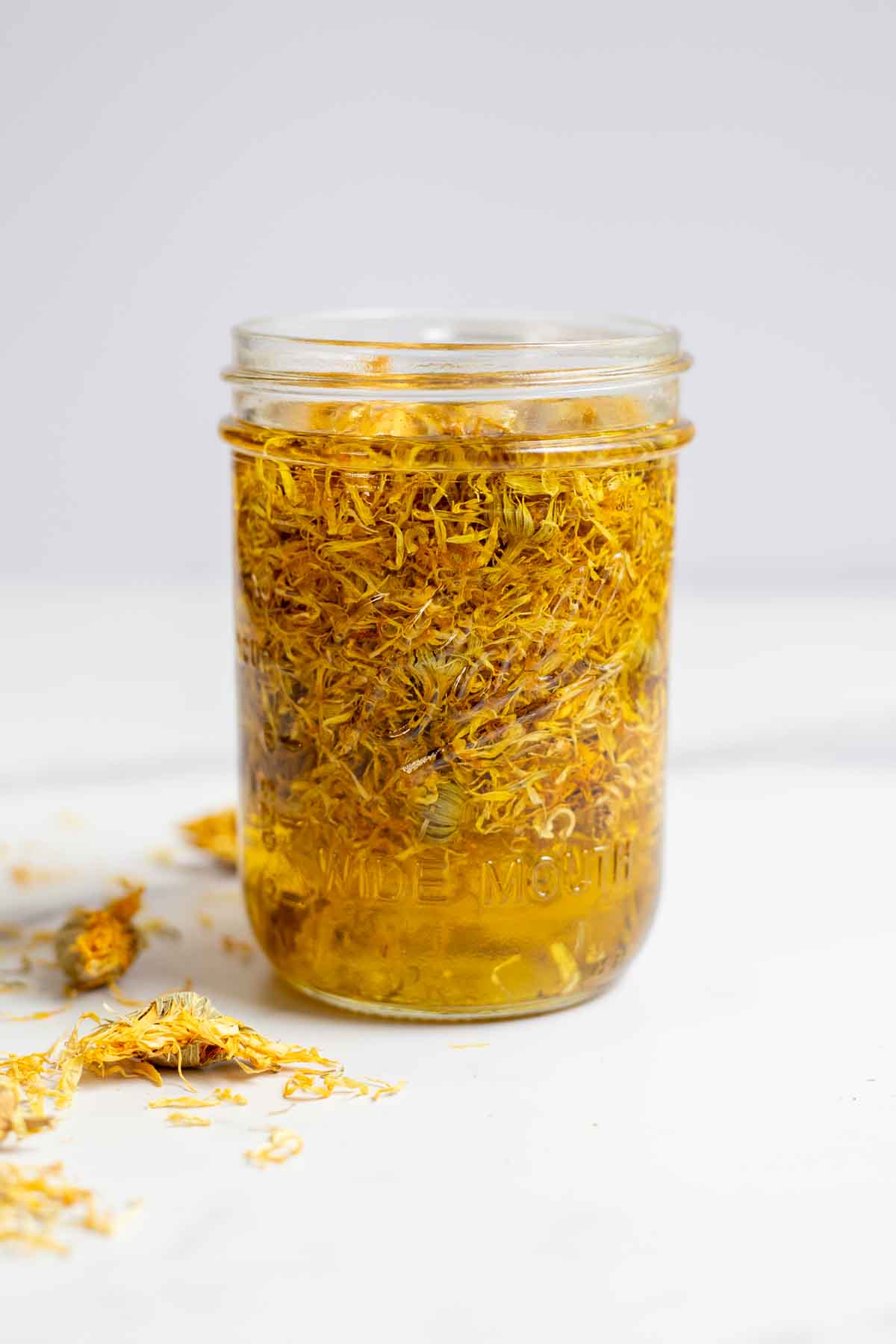
Calendula officinalis, aka calendula, or pot marigold, is an easy-to-grow perennial plant with bright orange or yellow flowers.
But it’s not just pretty, it’s also a medicinal plant with a wide variety of medicinal uses. This edible flower can be used to make poultices to treat stings, scrapes, cuts, burns, sore muscles, bug bites, skin irritations, and more!
You can use the flower petals or whole flower head to make tea, which, when consumed, helps treat diarrhea, nourishes your liver, and supports your immune system. You can even make a tincture with it to help toothaches.
But our favorite way to use calendula is to make a calendula-infused oil for topical use. This oil can be used to help treat all kinds of skin conditions including ringworm, athlete’s foot, thrush, diaper rash (use it to make diaper cream), cradle cap, acne, and eczema.
It’s good for sensitive skin (make lotion bars with this oil), easy on your wallet, and is a must-have medicinal herb for your garden and pantry.
Why Make Homemade Calendula Oil?
- It’s soothing and healing to the skin.
- It has antimicrobial and anti-inflammatory properties.
- It’s easy to make. (Sidenote: if you grow calendula in your garden it will come back year after year in greater abundance than before, as long as you leave some of the flower heads on the plant to go to seed.)
- It’s inexpensive.
Ingredients
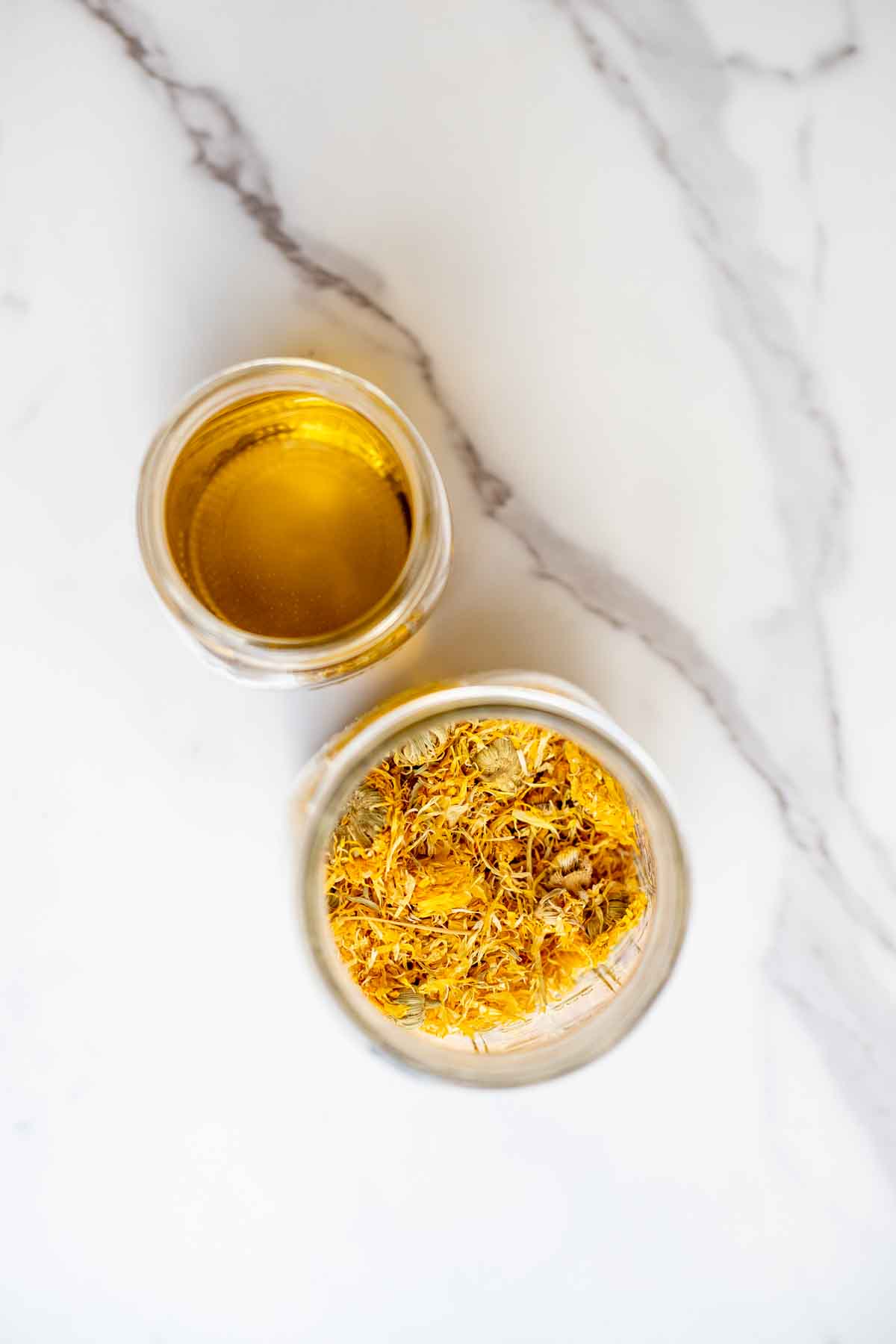
The key ingredient for this recipe is dried calendula petals or whole flower heads. If you don’t have calendula growing in your garden you can buy dried calendula online.
The only other ingredient for this recipe is your choice of carrier oil.
Tools Needed
- Clippers for cutting the flower heads off the plant
- Screens or trays on which to dry the flowers or a food dehydrator (optional, used for quickly drying your flowers)
- Mason jar
- Double boiler (for making a quick infusion)
How to Harvest Calendula Flowers
As soon as flowers begin appearing in the spring, gently pull or clip them off the plant. The more you harvest, the more the flowers will grow. Harvest in the morning when the flowers are freshest.
How to Dry Calendula Flowers
You can dry your flowers the same way you would dry any fresh herbs. Harvest them and place them on screens or hang them in a sunny windowsill at room temperature. If you have a lot of flowers at once, you can also dry them in a dehydrator.
How to Make Your Own Calendula Oil
There are three different ways to make calendula-infused oil. The first method is the best, in our opinion, for harnessing the full power of the calendula. The second and third options involve sun or heat, which speeds up the infusion.
Save This Recipe
Slow Infusion: The first Method
is a folk method, but don’t let the term “folk method” scare you! It’s just the traditional, S L O W method for infusing herbs.

Step 1: Simply place your dried calendula flowers in a mason jar, making sure to not cram them in too tight.
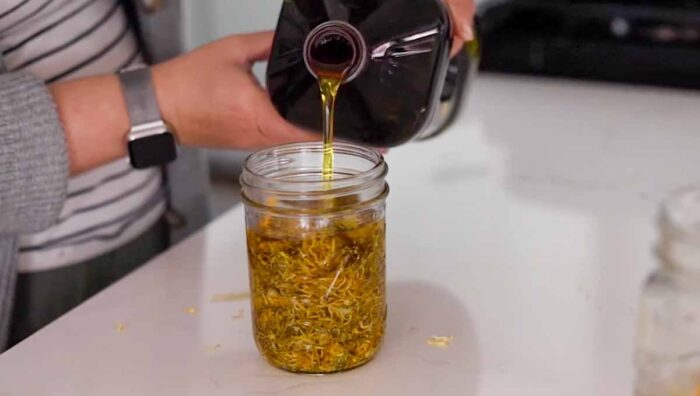
Step 2: Cover them entirely with your choice of oil. Then place your jar in a dark place for four to six weeks. Shake your oil mixture daily. It’s okay if you forget, but it will help the process along, so don’t forget too often! After six weeks, strain out the flowers, and your herb-infused oil is ready to use.
Quick Infusion: The second method:
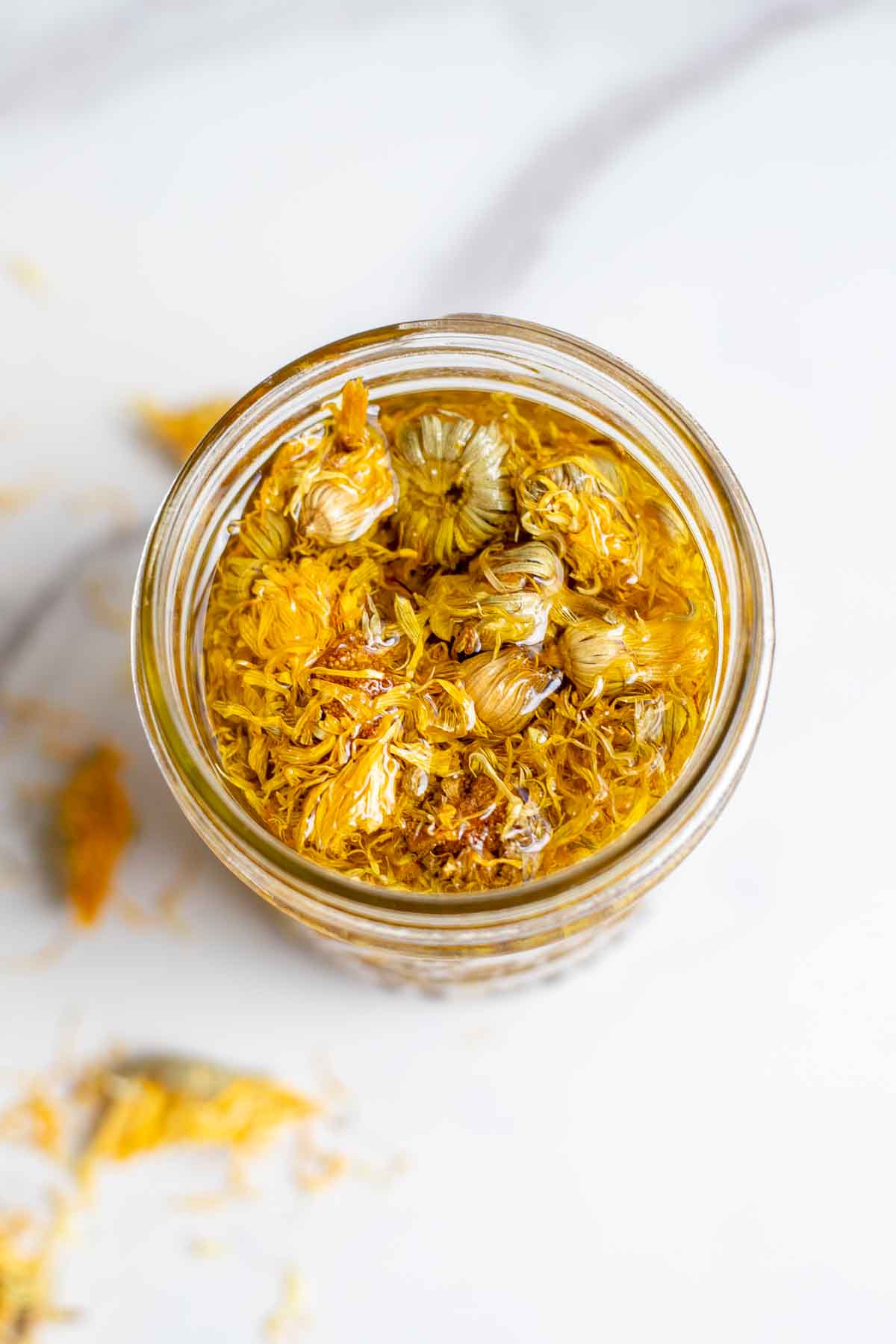
This method is quick (compared to six weeks!), and instead of dried flowers, you can use relatively fresh ones.
Step 1: Allow your freshly picked flowers to wilt a little before beginning this process. Allowing them to wilt overnight would be enough.
Step 2: Place your wilted flowers in a clean glass jar. A pint jar is big enough to make a good amount of oil. Place the flowers gently in the jar, don’t cram them in.
Step 3: Then cover the flowers with your oil of choice. Cover the jar with a breathable fabric like cheesecloth and secure it in place with a metal ring or rubber band. Finally, place the jar in direct sunlight for a week. You can stir the oil mixture every day to help the infusion process along. The heat from the sun helps the infusion process, so make sure to place your jar where it will get the most sun possible.
The third method is a quick infusion, and it’s the only method we recommend for using coconut oil. So if you choose coconut oil as your carrier oil, you will need to follow this method.
- Set up a double boiler (or a small saucepan with a bowl that rests perfectly on top without falling into the pan).
- Put a few inches of water in the bottom, and place your calendula flowers covered with carrier oil on the top.
- Turn the burner on medium heat. Bring the water in the bottom of the pan to a boil, and then turn down to a simmer on low heat. The oil mixture should simmer for a couple of hours.
- Watch the water level in the pan and add more to the bottom as needed.
- After two hours turn the heat off and let your mixture cool. Then strain it and it will be ready to use.
What are the best carrier oils for making calendula-infused oil?
Olive oil is a great option if you want to use the infused oil straight, or if you plan to take it internally. If you plan to make salves, lotion bars, whipped body butter, or other body products with your calendula oil, try infusing with jojoba oil, sweet almond oil, or grapeseed oil.
You can also use coconut oil, but you will have to use the quick infusion method since coconut oil is solid at room temperature.
How to use your calendula-infused oil
- Use as-is directly on dry skin, rashes, sunburns, or other skin ailments.
- Make a calendula oil-infused honey lip balm. Just swap out the almond oil.
- Make our whipped body butter recipe, but instead of using plain coconut oil, use calendula-infused coconut oil as the key ingredient.
- Make a calendula-based homemade healing salve. Just swap out the olive oil for calendula oil. Or, if you did the quick infusion method and used coconut oil, you can swap out the regular coconut oil for the calendula-infused coconut oil.
- Use it in our recipe for nourishing lotion bars.
Storage
Store your calendula oil infusion in an airtight jar out of direct sunlight. Under the bathroom sink is our “cool dark place” of choice. Calendula oil has a long shelf life. We have a jar from last year that is still going strong!
FAQ
It’s not recommended as fresh flowers contain more water, and therefore can lead to mold during the infusion. Let your flowers wilt before doing the second method, or dry them fully for the first or third method.
Yes. Use a carrier oil you know you can trust.
Want to make other herbal recipes?
- Try this dandelion oil.
- Or follow our guide for DIY herbal infused oils.
- You also might enjoy this rosemary oil for hair growth.
- Lilac syrup
- How to make lilac sugar
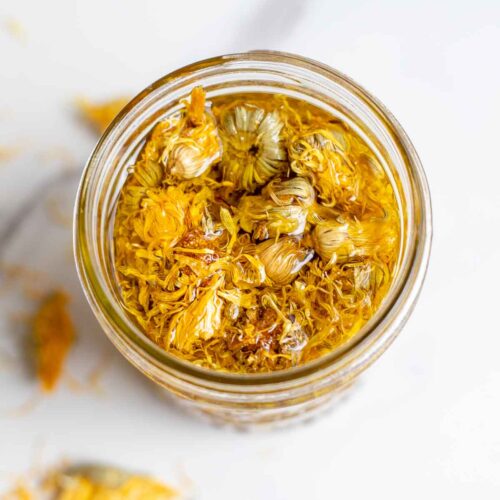
How To Make Calendula Oil
Save This Recipe
Ingredients
- 3/4 cup dried calendula flowers
- 1 cup oil or enough to cover the flowers
Instructions
Slow infusion:
- Simply place your dried calendula flowers in a mason jar, making sure to not cram them in too tight, and cover them entirely with your choice of oil.
- Then place your jar in a dark place for four to six weeks.
- Shake your oil mixture daily. It’s okay if you forget, but it will help the process along, so don’t forget too often! After six weeks, strain out the flowers, and your herb-infused oil is ready to use.
Quick infusion:
- Set up a double boiler (or a small saucepan with a bowl that rests perfectly on top without falling into the pan).
- Put a few inches of water in the bottom, and place your calendula flowers covered with carrier oil on the top. Turn the burner on medium heat.
- Bring the water in the bottom of the pan to a boil, and then turn down to a simmer on low heat. The oil mixture should simmer for a couple of hours.
- Watch the water level in the pan and add more to the bottom as needed. After two hours turn the heat off and let your mixture cool. Then strain it and it will be ready to use.
Notes
- It’s not recommended as fresh flowers contain more water, and therefore can lead to mold during the infusion. Let your flowers wilt before doing the second method, or dry them fully for the first or third method.
- If you want to use coconut oil, use the quick infusion method.


